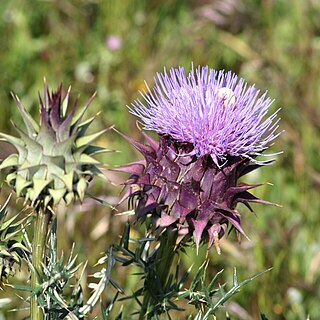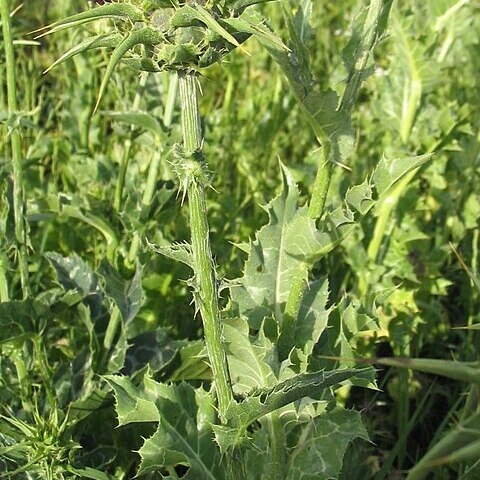Heads discoid, the fls all tubular and perfect; invol bracts imbricate, broad and firm, most of them spiny-margined and strongly spine-tipped; receptacle flat, densely setose; cors purple, with slender tube and long narrow lobes; filaments glabrous, connate at least below; anthers with a firm, slender, terminal appendage, shortly tailed at the base; style with an abrupt change of texture below the connate, papillate branches; achenes basifixed, somewhat compressed, glabrous; pappus of numerous slender, unequal, subpaleaceous bristles, deciduous in a ring; spiny winter-annual or biennial with alternate lvs and large, globose heads terminating the branches. 2, Mediterranean.
Annual or biennial herbs. Stems erect, strongly branched, longitudinally striate; wings absent. Leaves oblanceolate, coarsely sinuate with spine-tipped lobes; upper leaves auriculate. Capitula pedunculate, homogamous. Involucral bracts spine-tipped; margins pectinate, spinose. Receptacle flat to slightly convex, not alveolate, densely setose. Corolla purple; tube filiform; limb conspicuously expanded; lobes linear. Anther filaments connate, glandular. Style branches connate, erect. Achenes obovoid, smooth, glabrous, with narrow apical rim; carpopodium sub-basal. Pappus deciduous, of numerous barbellate capillary bristles, united in a ring at base.
Herbs with basal rosette of lobed leaves, and with alternate entire cauline leaves. Capitula solitary, homogamous; involucre globose; phyllaries pluriseriate, with spiny margins; receptacle flat, fleshy, densely setose. Corolla with filiform tube, lobes oblique, filaments connate in a tube, glandular; anthers with very short tails. Pappus 3-seriate, barbellate.


